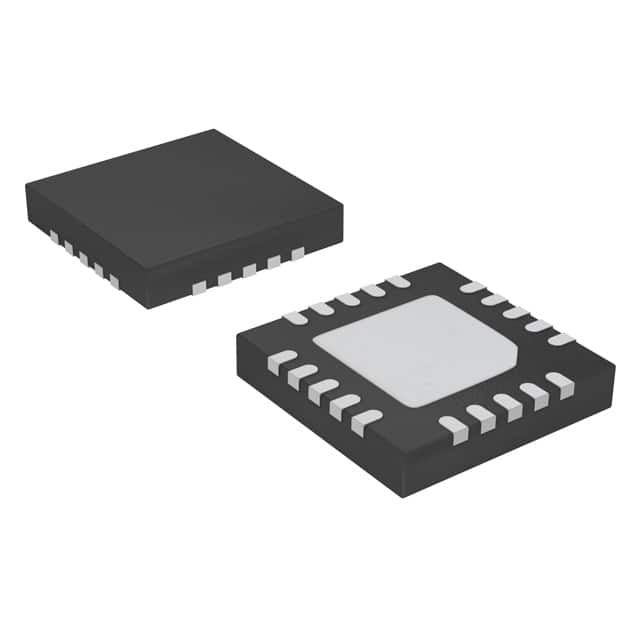Lihat spesifikasi untuk detail produk.

SI5310-C-GM
Product Overview
Category
SI5310-C-GM belongs to the category of integrated circuits (ICs).
Use
SI5310-C-GM is commonly used in electronic devices for signal processing and frequency synthesis.
Characteristics
- High precision and stability
- Low power consumption
- Compact size
- Wide operating temperature range
Package
SI5310-C-GM is available in a small form factor package, such as QFN (Quad Flat No-leads) or BGA (Ball Grid Array).
Essence
The essence of SI5310-C-GM lies in its ability to generate accurate and stable clock signals for various applications.
Packaging/Quantity
SI5310-C-GM is typically packaged in reels or trays, with quantities varying based on customer requirements.
Specifications
- Frequency range: 1 Hz - 1 GHz
- Output voltage: 3.3V
- Operating temperature: -40°C to +85°C
- Supply voltage: 2.7V - 5.5V
- Package dimensions: 5mm x 5mm
Detailed Pin Configuration
SI5310-C-GM has a total of 20 pins. The pin configuration is as follows:
- VDDA
- GND
- XIN
- XOUT
- VDDC
- GND
- CLK_OUT0
- CLK_OUT1
- CLK_OUT2
- CLK_OUT3
- GND
- VDDC
- SDA
- SCL
- GND
- VDDC
- NC
- NC
- GND
- VDDA
Functional Features
- Frequency synthesis with high accuracy
- Multiple output clock signals
- Programmable frequency divider
- I2C interface for configuration and control
Advantages and Disadvantages
Advantages
- High precision and stability in clock signal generation
- Low power consumption, suitable for battery-powered devices
- Compact size, enabling integration into space-constrained designs
- Wide operating temperature range, suitable for various environments
Disadvantages
- Limited frequency range (up to 1 GHz)
- Requires external components for proper operation
Working Principles
SI5310-C-GM utilizes a phase-locked loop (PLL) architecture to generate precise clock signals. The PLL locks onto an input reference frequency and generates multiple output clocks with programmable dividers.
Detailed Application Field Plans
SI5310-C-GM finds applications in various fields, including:
- Telecommunications: Used in network equipment for synchronization and timing purposes.
- Consumer Electronics: Integrated into audio/video devices, set-top boxes, and gaming consoles for clock synchronization.
- Industrial Automation: Employed in industrial control systems and data acquisition devices for accurate timing.
- Automotive: Utilized in automotive electronics for clock synchronization in infotainment systems and advanced driver-assistance systems (ADAS).
Detailed and Complete Alternative Models
- SI5338-A-GM: Similar functionality with a wider frequency range of up to 2.5 GHz.
- SI5341-B-GM: Offers additional features such as jitter attenuation and spread spectrum modulation.
These alternative models provide similar functionality to SI5310-C-GM but may have different specifications and package options.
In conclusion, SI5310-C-GM is an integrated circuit used for generating accurate and stable clock signals. It offers high precision, low power consumption, and compact size. Its applications span across telecommunications, consumer electronics, industrial automation, and automotive industries. Alternative models like SI5338-A-GM and SI5341-B-GM provide similar functionality with varying specifications.
Sebutkan 10 pertanyaan dan jawaban umum terkait penerapan SI5310-C-GM dalam solusi teknis
Sure! Here are 10 common questions and answers related to the application of SI5310-C-GM in technical solutions:
Q: What is the SI5310-C-GM?
A: The SI5310-C-GM is a clock generator and jitter attenuator integrated circuit (IC) designed for use in various technical solutions.Q: What are the key features of the SI5310-C-GM?
A: The SI5310-C-GM offers low jitter, multiple output clocks, programmable frequency synthesis, and flexible input/output options.Q: How can I interface the SI5310-C-GM with other components?
A: The SI5310-C-GM supports various interfaces such as I2C, SPI, and SMBus, allowing easy integration with other devices.Q: Can the SI5310-C-GM generate different clock frequencies simultaneously?
A: Yes, the SI5310-C-GM can generate multiple output clocks with different frequencies, making it suitable for applications requiring diverse timing signals.Q: Is the SI5310-C-GM compatible with different supply voltages?
A: Yes, the SI5310-C-GM operates with a wide range of supply voltages, typically between 1.8V and 3.3V.Q: Does the SI5310-C-GM support spread spectrum clocking (SSC)?
A: Yes, the SI5310-C-GM provides built-in support for SSC, which helps reduce electromagnetic interference (EMI) in high-speed designs.Q: Can I program the SI5310-C-GM using software?
A: Yes, the SI5310-C-GM can be easily programmed using dedicated software tools provided by the manufacturer.Q: What is the typical jitter performance of the SI5310-C-GM?
A: The SI5310-C-GM offers low jitter performance, typically in the range of picoseconds (ps), ensuring accurate and reliable timing.Q: Is the SI5310-C-GM suitable for high-speed data communication applications?
A: Yes, the SI5310-C-GM is designed to meet the requirements of high-speed data communication systems, including Ethernet and optical networking.Q: Are evaluation boards available for the SI5310-C-GM?
A: Yes, evaluation boards are available for the SI5310-C-GM, allowing engineers to test and validate its performance in their specific applications.
Please note that these questions and answers are generic and may vary depending on the specific requirements and use cases of the SI5310-C-GM in different technical solutions.

